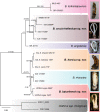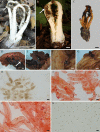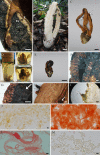Diversity trapped in cages: Revision of Blumenavia Möller (Clathraceae, Basidiomycota) reveals three hidden species
- PMID: 32357194
- PMCID: PMC7194408
- DOI: 10.1371/journal.pone.0232467
Diversity trapped in cages: Revision of Blumenavia Möller (Clathraceae, Basidiomycota) reveals three hidden species
Abstract
Basidiomata of Phallales have a diversified morphology with adhesive gleba that exudes an odor, usually unpleasant that attracts mainly insects, which disperse the basidiospores. The genus Blumenavia belongs to the family Clathraceae and, based on morphological features, only two species are currently recognized: B. rhacodes and B. angolensis. However, the morphological characters adopted in species delimitations within this genus are inconsistent, and molecular data are scarce. The present study aimed to review and identify informative characters that contribute to the delimitation of Blumenavia species. Exsiccates from America and Africa were analyzed morphologically, and molecularly, using ITS, LSU, ATP6, RPB2 and TEF-1α markers for Maximum Parsimony, Bayesian and Maximum likelihood analyses, and also for coalescent based species delimitations (BP&P), as well as for bPTP, PhyloMap, Topo-phylogenetic and Geophylogenetic reconstructions. According to our studies, seven species can be considered in the genus: B. rhacodes and B. angolensis are maintained, B. usambarensis and B. toribiotalpaensis are reassessed, and three new species are proposed, B. baturitensis Melanda, M.P. Martín & Baseia, sp. nov., B. crucis-hellenicae G. Coelho, Sulzbacher, Grebenc & Cortez, sp. nov., and B. heroica Melanda, Baseia & M.P. Martín, sp. nov. Blumenavia rhacodes is typified by selecting a lectotype and an epitype. Macromorphological characters considered informative to segregate and delimit the species through integrative taxonomy include length of the basidiomata, color, width and presence of grooves on each arm as well as the glebifer position and shape. These must be clearly observed while the basidiomata are still fresh. Since most materials are usually analyzed after dehydration and deposit in collections, field techniques and protocols to describe fugacious characters from fresh specimen are demanded, as well as the use of molecular analysis, in order to better assess recognition and delimitation of species in Blumenavia.
Conflict of interest statement
The authors have declared that no competing interests exist.
Figures











References
-
- Miller OK, Miller H. Gasteromycetes: morphological and developmental features with keys to the Orders, Families, and Genera. Eureka, CA, Mad River Press; 1988.
-
- Möller A. Brasilische Pilzblumen. Botanische Mitteilungen aus den Tropen 7; 1895.
-
- Dring DM. Contributions towards a rational arrangement of the Clathraceae. Kew Bulletin. 1980;35: 1–96.
-
- Welwitsch F, Currey F. Fungi Angolenses. A description of the fungi collected by Dr. Friedrisch Welwitsch in Angola during the years 1850–1861. Part I. Transactions of the Linnean Society of London. 1870;26: 279–294.
Publication types
MeSH terms
Substances
Grants and funding
LinkOut - more resources
Full Text Sources

